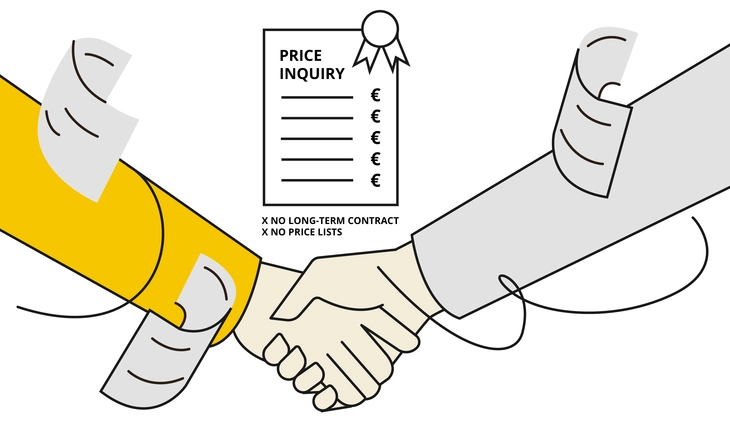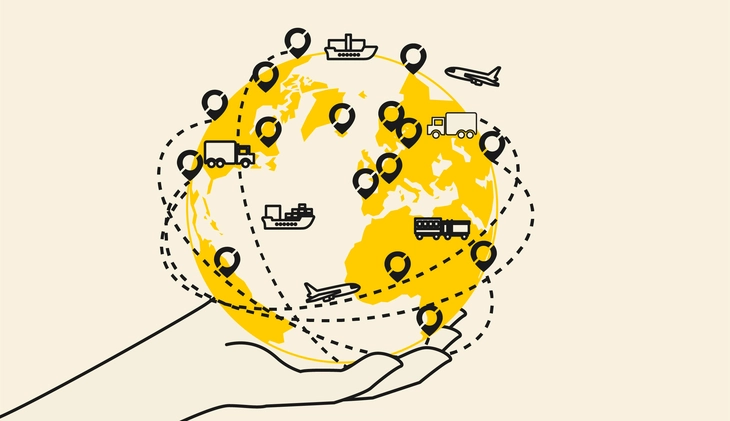Logistics, especially transport management, is one of the areas that hasn’t quite caught up with technology. If organizing transport of goods is one of your daily responsibilities, there might be quite a few activities you can automate. This could save you hours on routine tasks daily, which you can use to focus on the tasks that technology can’t quite handle yet.
We have compiled a list of logistics tasks that can easily be delegated to technology today.
1. Notifying your customers, business partners and colleagues about transport-related information
Old way:
- You log in to the website of one of your logistics providers and place a booking. You open your email service and send an email to your supplier to inform them of the expected collection date of the shipment.
- They send an email to request the truck registration number from you.
- You send an email to the carrier asking for the registration number.
- The carrier sends you the truck registration number.
- You send the same email back to the supplier.
- The shipment changed: there’s an additional pallet to collect, so you inform the carrier by email.
- The carrier receives the information, but they change the collection date and inform you by email.
- You forward the same information to your supplier.
- A few days after the shipment is completed, the carrier emails you the signed CMR.
New way:
- You log in to your freight management tool and place a booking. A notification with the expected collection date is automatically sent to your supplier.
- The carrier updates the truck registration number. Both you and your supplier receive automatic notifications.
- You update the shipment to contain an additional pallet. Your carrier and supplier receive the information automatically.
- The carrier updates the collection date and the updated ETA is automatically sent to you and your supplier.
- After the shipment is completed, the carrier uploads the signed CMR directly to your freight management software.
2. Communicating transport needs between your salespeople and logistics manager(s)
You have one or a few logistics managers, and a larger team of salespeople. The salespeople need to order transport of goods. The task of the logistics manager is to gather all the transport needs and arrange the transport.
Old way:
- Salespeople send emails or call the logistics manager(s) and communicate their transport needs.
- The logistics manager prepares a list of transport needs, decides which carrier to use for each, and organizes the transport using various carrier portals and/or sending emails.
- The logistics manager will be the middleman communicating information between salespeople and carriers.
New way:
- All salespeople enter their transport needs into a single system.
- Logistics managers see the new transport needs on their dashboard. They immediately have all of the decision criteria (price, ETAs, carbon emissions) and only need to decide on the best option.
- Salespeople can log in to the system whenever they need information about shipments.
3. Logging in to many different carrier websites every day
Old way:
- You have 6 carriers that your company works with: Carrier A, B, C, D, E and F.
- To send domestic parcels, you log into Carrier A’s system.
- For international parcels, you log into the Carrier B system.
- For domestic roadfreight, Carrier C does not have an online self-service portal, so you email them to order transport. But first you need to find the right person to contact, depending on the shipment route.
- For international roadfreight, you log into either Carrier D or the carrier E’s system, depending on the origin/destination.
- For seafreight, you log in to the Carrier F system.
New way:
The process of ordering transport is exactly the same for any carrier you work with. Carriers receive your shipments either directly into their software or via email, depending on their capabilities and preferences. You don’t need to worry about these details.
4. Training employees to use a new carrier software
Old way:
- A new year has arrived and you have switched some of your logistics service providers. This means that you will have to familiarize yourself with the new software and train your team to do the same.
- There is a new member in your team who needs to be trained to use all of the different carriers’ software systems and websites. You will either have to share your passwords or create new accounts for them in all of the systems. In some cases, it may take a few days or even weeks.
- They will also need a list of all the freight forwarders and/or account managers for all of your carriers to contact regarding transportation orders, statuses and changes.
New way:
- You use a one-access-point transport management software (TMS). Therefore, switching logistics service providers will not bring any changes to your workflow.
- You train new team members to use one system rather than ten.
- All your relevant contacts are found automatically for each shipment and carrier.
5. Bringing your colleague up to date with the latest transports before going on a holiday
Old way:
You’re going on a holiday, but first you need to bring your colleague up to date with the latest, ongoing and upcoming shipments. With shipment information spread across various carrier systems, email conversations and Excel spreadsheets, it can be quite a challenge.
New way:
Your colleague has an account in your freight management software. After a quick scroll through the dashboard, they will already be up to date and ready to take over while you’re not there.
6. „How much would this shipment cost?“
You work with 5 carriers, and you have a shipment for which you need to find prices for each carrier, so you can choose the best offer.
Old way:
- You have pre-agreed price lists with all of your carriers. You either have them printed out or in a PDF/Excel format on your computer.
- You calculate the shipment’s payable weight, and trace your finger through all of the price lists to find the applicable price.
- Don’t forget to check the carrier’s website for their current surcharges (e.g. BAF)
- You compile the calculation results in a list from which you can choose the best offer.
New way:
You use a freight rate management module, which allows you to upload your price lists into a system that can process them and do all the calculations for you in an instant.
7. Copy-pasting transport info from one software to another
Old way:
- You use an ERP (enterprise resource planning) software. When ordering transport, you copy the shipment information from the ERP to your logistics service provider’s software.
- You then copy some data from the carrier’s software back to your ERP.
- You have an online store with some automated shipping plugins installed, but you still need to copy-paste some information back to your ERP. (If the online store is your only point of sale, it isn’t much of a problem, though.)
New way:
- Your ERP or online store is integrated with your freight management software. You can send transportation orders directly from your ERP to any of your carriers, and automatically get back any information you need (labels, tracking numbers etc).
- Your online store is integrated with your ERP. From there, you can either use the ERP as a single source of all transport orders, or just sync information with the online store.
8. Generating company-wide, cross-carrier shipping reports and statistics
Old way:
- Your shipment history and statistics are scattered across the systems of different logistics service providers. Some might not even have a statistics module.
- To create a report, you first export or copy-paste the raw data from all of the carriers’ systems. You then import them all into Excel and standardize the formats, after which you can start generating insights from the data.
New way:
All your shipping history and statistics are easily accessible from a central source in a consistent format, regardless of carrier. From there you can either use the pre-generated insights, or export raw data and create your own.
So there we have it: 8 things that could be taking way too much time out of your day.
The best part? Cargoson can do all that and much more for you!
The best part? Cargoson can do all that and much more for you!
or


![How to Conduct a Simple Transport Tender? [+ free template] How to Conduct a Simple Transport Tender? [+ free template]](https://www.cargoson.com/rails/active_storage/representations/redirect/eyJfcmFpbHMiOnsibWVzc2FnZSI6IkJBaHBBeENsREE9PSIsImV4cCI6bnVsbCwicHVyIjoiYmxvYl9pZCJ9fQ==--0770c20699a76b88a052bbfa35e1ab55beb6d4d8/eyJfcmFpbHMiOnsibWVzc2FnZSI6IkJBaDdDRG9MWm05eWJXRjBPZ2wzWldKd09oSnlaWE5wZW1WZmRHOWZabWwwV3dkcEF0b0NhUUwwQVRvTVkyOXVkbVZ5ZERzRyIsImV4cCI6bnVsbCwicHVyIjoidmFyaWF0aW9uIn19--2c7d6c6b28c4d68db8f7c1f368d1bcdc6ab5275a/how-to-conduct-a-simple-transport-tender-freight-procurement-cargoson.jpg?locale=en)



![How to Select a Multi Carrier Shipping Software: 7 Tips [+ free checklist download] How to Select a Multi Carrier Shipping Software: 7 Tips [+ free checklist download]](https://www.cargoson.com/rails/active_storage/representations/redirect/eyJfcmFpbHMiOnsibWVzc2FnZSI6IkJBaHBBNlcrQ1E9PSIsImV4cCI6bnVsbCwicHVyIjoiYmxvYl9pZCJ9fQ==--17911efdfb74cab1a073d1c9c536393ecfacf242/eyJfcmFpbHMiOnsibWVzc2FnZSI6IkJBaDdDRG9MWm05eWJXRjBPZ2wzWldKd09oSnlaWE5wZW1WZmRHOWZabWwwV3dkcEF0b0NhUUwwQVRvTVkyOXVkbVZ5ZERzRyIsImV4cCI6bnVsbCwicHVyIjoidmFyaWF0aW9uIn19--2c7d6c6b28c4d68db8f7c1f368d1bcdc6ab5275a/CS_newsroom_Logistics%20ABC_How%20to%20Select%20a%20Multi%20Carrier%20Shipping%20Software.png?locale=en)